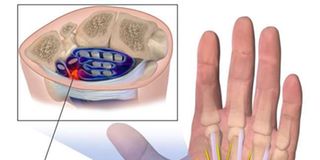Tingling or pain in fingers could be down to nerve irritation on the wrist

Tingling or pain in fingers could be down to nerve irritation on the wrist.
What you need to know:
- Usually these symptoms suggest irritation in a nerve and the commonest problem is called carpal tunnel syndrome
- The little finger is normally spared the symptoms while the thumb bears the brunt of it
- The nerve tests are able to confirm the diagnosis of carpal tunnel syndrome and also grade the severity
Frequently in sports that involve holding either a racquet, stick, or even handlebars, an athlete may experience tingling in the fingers or pins and needles over time.
This is a common complaint and the severity is variable. Usually these symptoms suggest irritation in a nerve and the commonest problem is called carpal tunnel syndrome.
The bones in the wrist are arranged in an arch and running through this arch are tendons but more importantly a nerve called the median nerve.
This nerve gives sensation to the thumb, index, middle and half of the ring finger.
From the position of the nerve in the wrist (see picture), we can appreciate that activities which involve holding onto something firmly (e.g. racquet, club or hockey stick) may place pressure on the nerve.
Usually it’s the tissue on top of the nerve (carpal ligament) which will thicken over time leading to abnormal nerve function.
The thickening of this band of tissue with subsequent pain in the fingers is known as carpal tunnel syndrome.
Most people experience the pain and tingling during physical activity or at night.
They often describe being woken up at night with the symptoms and having to shake their hands.
The little finger is normally spared the symptoms while the thumb bears the brunt of it.
When faced with these symptoms it is worth reviewing your sports equipment to check the level of padding in the handles.
A period of rest is useful to allow resolution of mild irritation around the nerve.
Nerve compression
Additionally reviewing your sports technique may be of benefit for example in golf where the grip technique may be the cause.
If the symptoms persist or get worse despite the above measures then a clinical assessment is necessary. This aims to establish the severity of the nerve compression and to prevent progression.
The most useful investigation is having nerve tests which are performed by neurologists.
The nerve tests are able to confirm the diagnosis of carpal tunnel syndrome and also grade the severity. Managing mild carpal tunnel syndrome normally involves the measures already mentioned and additionally using splints at night.
Physiotherapy may be useful in the early and mild phases of the condition.
When carpal tunnel is more advanced there is weakening and loss of the muscle bulk in the hand.
Minor surgery
The nerve tests normally diagnose sever carpal tunnel syndrome and at this stage review by a surgeon is recommended.
With severe symptoms the best treatment is having minor surgery to take pressure off the nerve.
The procedure is normally done with the individual awake under local anaesthetic.
The surgery involves making a small cut in the carpal ligament to release the pressure off the nerve. The improvement after surgery is fairly rapid and most people return to normal activity in two months.
It should be emphasised that carpal tunnel is a very common condition and also affects non-sporting individuals. Often there is no clear reason for developing the condition but the treatment is the same.
The important message is recognising the symptoms early and not allowing it to progress to the point of muscle weakness.




